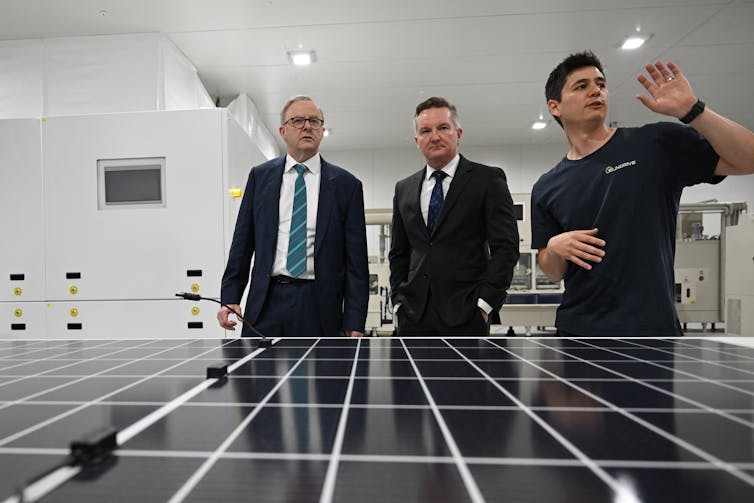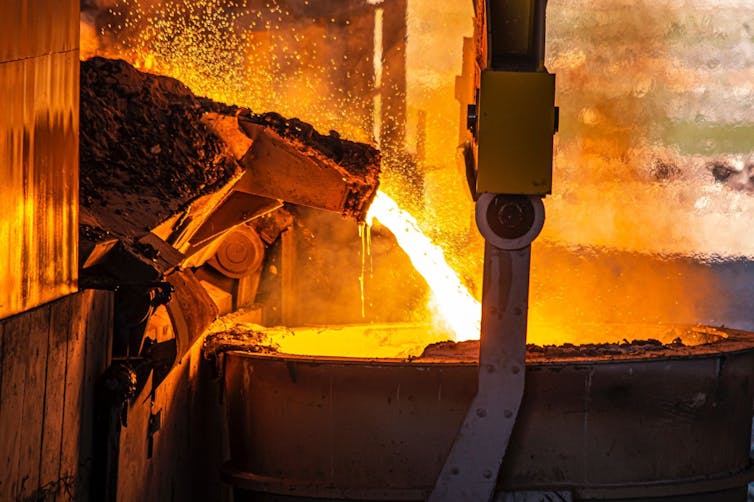In the budget last week, the government was keen to talk about its efforts to turn Australia into a renewable superpower under the umbrella of the Future Made in Australia policies.
Future Made is a framework that sets out how to target green subsidies to drive investment in everything from solar to critical minerals to green hydrogen. The policy lands at a time when the world is racing towards a future green economy. America has its Inflation Reduction Act, while the European Union has its Green Deal and China has powered ahead with green technologies.
The government hopes to make the most of Australia’s comparative advantage in this global context. Over 50 countries now have policies like this.
Future Made includes $1.9 billion in new funding for the Australian Renewable Energy Agency, $7 billion in tax incentives for critical mineral producers, and $1.5 billion for solar panel and battery manufacturing. Each of these has proven themselves. The renewable agency funded some of our first large-scale solar farms. Critical minerals such as lithium, cobalt and rare-earth elements are in demand to make electric vehicle batteries. And Australia is the world leader in rooftop solar, but makes almost none of the panels.
But what about green hydrogen, an industry still in its infancy? Future Made now has about $8 billion on offer to help kickstart Australia’s green hydrogen industry. Subsidies would cover the initial difference between the cost of production and current market price, until economies of scale kick in and the subsidy is phased out.
Renewable hydrogen is essential to make green iron, green steel and green ammonia, which we can use here or export.

Government-backed hydrogen?
Economists have long been critical of governments picking winners. To avoid this problem, Australia’s government has included a series of tests which have to be passed before it will invest public money. This rigour is worth praising.
These tests include how competitive the company is, how it will contribute to net zero, how it builds the capability of people and regions and how it would deliver value for money. As the government moves to become more interventionist, these tests act as a net zero filter, allocating public funds to enterprises which pass these tests. Scaled up, it will begin to shape the economy in ways compatible with net zero.
When applied to green hydrogen, these tests suggest it would be much more economic to produce green iron close to where green hydrogen is produced. That’s because hydrogen is difficult to transport.
You can make green hydrogen by using renewable electricity to split water – even better if you do it in the day, to soak up cheap solar power. The primary technology – machines called electrolysers – is becoming cheaper and more readily available.
Climateworks has modelled different emission reduction scenarios for the whole economy and found green hydrogen can play a role in the race to net zero – especially in sectors it’s not technically possible or too expensive to electrify, such as ammonia production, iron ore production, and heavy transport.

Making commercially viable green hydrogen at scale will be essential if we are to get to net zero. But without established local and global demand, public investment is needed to kickstart this industry at scale. That way, when the momentum builds for green hydrogen, Australia will be positioned to make best use of our comparative advantages and move from a smattering of pilot plants to large scale production.
If we get this right, we will be in demand globally. With our established export relationships, green hydrogen and the products it can help us make will be big ticket export items.
Right now, there’s a chicken and egg problem. Companies are reluctant to front up the initial capital costs if there’s uncertainty about who will buy the product. To scale up, then, means a mixture of grants and concessional finance to encourage entrants.
And because green hydrogen is trying to displace fossil fuels, manufacturers need to persuade buyers to shift. Steel magnate Sanjeev Gupta is confident many buyers will pay a little extra for green steel made with hydrogen with no need for subsidies, but we can’t yet see this in any uptick in demand.
Without established local and global demand, public investment is needed to kick start this industry at scale. The Future Made in Australia net zero filter sets out questions about competitiveness, emissions and more which must be asked and answered for Australia to spend public dollars efficiently. Applying these tests consistently will help us avoid the problems which come when we pick winners without enough evidence.
Under Climateworks’ modelling for a 1.5°C scenario, local renewable hydrogen production could grow steadily until 2030 and then accelerate rapidly to 2045.
It is true green hydrogen is having a sluggish start. Worldwide, electrolyser capacity is currently far outstripping demand, except in China. In part, this is because green hydrogen will have most use in industry, which has been slower to decarbonise.
Future Made and similar policies around the world offer a chance – not a certainty – of cracking the chicken and egg problem. If done well, Future Made could be the running start Australia needs to gain the benefits from our comparative advantages in world class solar and wind resources, critical minerals, a skilled workforce, established export relationships and the sheer size of our landmass and coastline to host large scale projects.
The managers of almost half of the world’s privately managed money have pledged to invest in line with limiting global warming to 1.5°C. It’s time for us to put Australia’s public investment to work. On green hydrogen, we could shoot to the front of the pack. It’s still up for grabs.
Read more: Green industry yes, conservation no: a budget for people, not for nature

